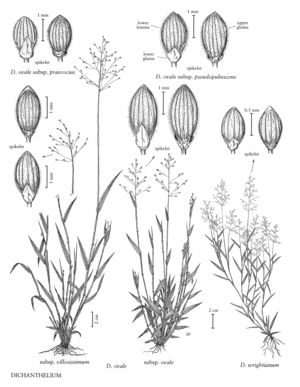Difference between revisions of "Dichanthelium ovale subsp. ovale"
FNA>Volume Importer |
imported>Volume Importer |
||
| (8 intermediate revisions by 2 users not shown) | |||
| Line 1: | Line 1: | ||
{{Treatment/ID | {{Treatment/ID | ||
|accepted_name=Dichanthelium ovale subsp. ovale | |accepted_name=Dichanthelium ovale subsp. ovale | ||
| − | |accepted_authority= | + | |accepted_authority= |
|publications= | |publications= | ||
|basionyms= | |basionyms= | ||
|synonyms={{Treatment/ID/Synonym | |synonyms={{Treatment/ID/Synonym | ||
|name=Panicum malacon | |name=Panicum malacon | ||
| − | |authority= | + | |authority= |
| + | |rank=species | ||
}} | }} | ||
|hierarchy=Poaceae;Poaceae subfam. Panicoideae;Poaceae tribe Paniceae;Dichanthelium;Dichanthelium sect. Lanuginosa;Dichanthelium ovale;Dichanthelium ovale subsp. ovale | |hierarchy=Poaceae;Poaceae subfam. Panicoideae;Poaceae tribe Paniceae;Dichanthelium;Dichanthelium sect. Lanuginosa;Dichanthelium ovale;Dichanthelium ovale subsp. ovale | ||
| Line 18: | Line 19: | ||
-->{{Treatment/Body | -->{{Treatment/Body | ||
| − | |discussion=<p>Dichanthelium ovale subsp. ovale grows in dry, open, sandy woods, pinelands, and sandhills along the east coast of the United States from New Jersey south¬wards, extending into the coastal plain from eastern Texas to South Carolina, and in Mexico, Honduras, Guatemala, and Nicaragua. It intergrades somewhat with subsp. pseudopubescens. Occasional long-spikelet specimens exhibit morphological characteristics of D. oligosanthes and D. commutatum.</p> | + | |discussion=<p><i>Dichanthelium ovale </i>subsp.<i> ovale</i> grows in dry, open, sandy woods, pinelands, and sandhills along the east coast of the United States from New Jersey south¬wards, extending into the coastal plain from eastern Texas to South Carolina, and in Mexico, Honduras, Guatemala, and Nicaragua. It intergrades somewhat with <i></i>subsp.<i> pseudopubescens</i>. Occasional long-spikelet specimens exhibit morphological characteristics of <i>D. oligosanthes</i> and <i>D. commutatum</i>.</p> |
|tables= | |tables= | ||
|references= | |references= | ||
| Line 27: | Line 28: | ||
-->{{#Taxon: | -->{{#Taxon: | ||
name=Dichanthelium ovale subsp. ovale | name=Dichanthelium ovale subsp. ovale | ||
| − | + | |authority= | |
| − | |authority= | ||
|rank=subspecies | |rank=subspecies | ||
|parent rank=species | |parent rank=species | ||
| Line 34: | Line 34: | ||
|basionyms= | |basionyms= | ||
|family=Poaceae | |family=Poaceae | ||
| + | |illustrator=Linda A. Vorobik;Hana Pazdírková | ||
| + | |illustration copyright=Utah State University | ||
|reference=None | |reference=None | ||
|publication title= | |publication title= | ||
|publication year= | |publication year= | ||
|special status= | |special status= | ||
| − | |source xml=https:// | + | |source xml=https://bitbucket.org/aafc-mbb/fna-data-curation/src/200273ad09963decb8fc72550212de541d86569d/coarse_grained_fna_xml/V25/V25_1169.xml |
|subfamily=Poaceae subfam. Panicoideae | |subfamily=Poaceae subfam. Panicoideae | ||
|tribe=Poaceae tribe Paniceae | |tribe=Poaceae tribe Paniceae | ||
Latest revision as of 17:55, 11 May 2021
Basal blades 3-8 cm, rigid, with long hairs on or near the bases and margins. Culms more than 1 mm thick, stiff; lower internodes pilose; upper internodes short-pilose to nearly glabrous. Cauline sheaths with ascending hairs, hairs to 4 mm, not papillose-based: ligules 1-4 mm; blades 5-12 mm wide, firm, ascending, abaxial surfaces appressed-pubescent, adaxial surfaces nearly glabrous except for the long hairs on or near the scabridulous margins and bases. Spikelets 2.5-3 mm, ellipsoid, sparsely to densely pilose. 2n = 18.
Discussion
Dichanthelium ovale subsp. ovale grows in dry, open, sandy woods, pinelands, and sandhills along the east coast of the United States from New Jersey south¬wards, extending into the coastal plain from eastern Texas to South Carolina, and in Mexico, Honduras, Guatemala, and Nicaragua. It intergrades somewhat with subsp. pseudopubescens. Occasional long-spikelet specimens exhibit morphological characteristics of D. oligosanthes and D. commutatum.
Selected References
None.
